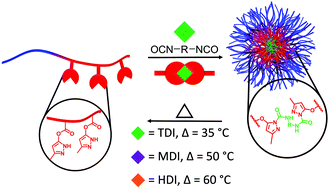The application of blocked isocyanate chemistry in the development of tunable thermoresponsive crosslinkers†
Abstract
The synthesis of a novel monomer, methacryloyl pyrazole, and its subsequent reaction with diisocyanates to produce thermoresponsive crosslinkers is reported. Incorporation of the crosslinkers via a post-polymerization reaction between the linear, methacryloyl pyrazole functionalized polymer chains and a diisocyanate produced crosslinked polymeric particles with a core–shell structure, which have been characterized using a variety of analytical techniques including triple-detection size exclusion chromatography (SEC), dynamic light scattering (DLS) and transmission electron microscopy (TEM). The thermally triggered deblocking of the blocked isocyanate crosslinker has been evaluated using SEC analyses and variable temperature 1H NMR spectroscopy, where it has been demonstrated that the temperature of deblocking, and therefore the temperature of particle degradation, can be tuned through variance in the diisocyanate used, producing a range of particles able to deblock between 35 °C and 65 °C. These results provide a promising way of readily tuning particle degradation through a simple post-synthesis assembly approach.



 Please wait while we load your content...
Please wait while we load your content...